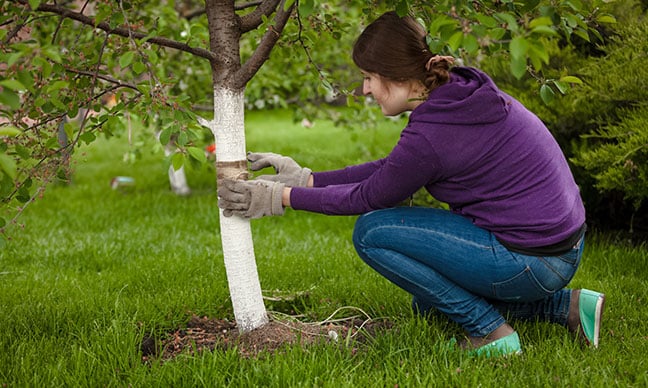Trees are a great investment in Texas. Not only do they enhance beauty and keep the air clean, but the shade and cool breeze they provide to the residents is really something to die for when the blazing summers kick in.
Unfortunately, trees are susceptible to diseases that may affect their growth, preventing them from serving the purpose they are intended for. Some may even lead to death!
Read on to find out some of the tree diseases Texas homeowners fight on a daily basis in their mission to achieve a healthy greenery.
5 Deadliest Tree Diseases Texas Gardeners Should Be Aware Of
There are plenty of diseases that affect trees in Texas, which could result in premature death. Here are the top five and how to spot them.
1. Bacteria Leaf Scorch
Bacteria leaf scorch is a deadly disease that causes the leaves to ‘burn’ around the outer edges. It is transmitted by the insects and pests that feed on the water-conducting tissue (xylem) of the plant.
These insects attack and clog the xylem, hindering the transportation of water from the roots to the leaves. The leaves start to die from the tips. The dead leaves usually appear brown, with a halo between the dead tissue and the green one. These symptoms reappear every year and eventually kill the tree.
Unfortunately, bacteria leaf scorch has no treatment. The only way to prevent it is by caring for your trees and having them checked regularly by a tree expert. Applying pesticides regularly to keep insects at bay can be a great place to start and any tree service Texas professional can help you with this.
2. Oak Wilt
The rate at which oak trees are dying in Texas is worrying and perhaps you may want to know, “What is killing oak trees in Texas?” Well, oak wilt is. This is among the deadliest oak tree diseases Texas gardeners deal with. It spreads through root grafts or by nitidulid beetles and if quick action is not taken, you could easily lose your tree.
Oak wilt affects all oak varieties but red oaks have been found to have the highest vulnerability. It White oaks are more resistant while live oaks are somewhere in between. When the disease attacks, the leaves wither and turn brown but remain attached to their branches. 5 to 6 weeks later, the tree starts to die.
Like bacteria leaf scorch, very little can be done once the tree is infected, so spray your oaks regularly to keep pests away and have all your root grafting done by an expert.
Related Post: Treating Oak Wilt
3. Hypoxylon Canker
Hypoxylon canker is one of the most common tree diseases in Fort Worth, Dallas, and Austin. The disease mostly strikes trees that are stressed and those with weakened immune system, often during a drought, and these places are no stranger to droughts.
The main targets are usually the oaks, and this ranks hypoxylon canker among the top oak tree diseases Texas landscapers need to be on the lookout for. It can also infect pecans, elms, and sycamores, although this is not a very common phenomenon.
If a tree is infected, the bark will start peeling off and the leaves will begin to fall starting on the upper branches. You will also notice dark spores on the trunk. Trees that suffer from this disease cannot be treated but you can help prevent it by keeping your trees healthy. Water regularly especially during the dry season.
4. Dutch Elm Disease
If you have elms in your property, you may want to watch out for the Dutch elm disease. Though it is more prevalent in North Texas, it makes the list because once it attacks, the results can be extremely devastating. This disease has wiped out a huge part of the elm population in the Midwest and Northeast, mostly affecting the Cedar elm.
Dutch elm disease is transmitted by borers and bark beetles. When a tree catches it, the leaves turn yellow and begin to wither from the top going downward. Eventually, the disease infects the roots and the tree dies. Dutch elm is not treatable, but it can be prevented by giving your trees regular care.
5. Fire Blight
Fire blight is caused by a bacteria, and when it attacks, the leaves of the infected tree appear burned. Apart from the scorched leaves, the trunk and branches produce cankers that secrete a sticky substance.
The disease is more prevalent in fruit trees in Dallas and can be transported to other trees by insects and birds. It spreads quickly and like any other disease we have highlighted above, it is incurable. However, it can be prevented by treating your trees regularly with fungicides.
What Does Oak Tree Fungus Look Like?
There are different types of fungi that attack oak trees, and these trees will react differently depending on the type of fungus and the level of damage caused. However, most fungi will cause a tree to:
- Rot from the inside
- Develop blisters in the bark
- Lose its leaves and bark
- Decay, forming tiny dark-colored spores in the trunk and branches
What Is Tree Bark Disease?
Tree bark disease is an ailment that occurs when a fungus infects the bark of a tree, causing cankers in the limbs and a brown discoloration in the bark. The fungus penetrates the tree through wounds or holes caused by natural stressors and/or insects. If not addressed quickly, these cankers can grow up to 60 cm in length along the infected branch, breaking the bark and killing it.
The Local Tree Experts Overview
Tree diseases can be a nightmare and could render a once green, vibrant yard lifeless. Most of the tree diseases Texas residents deal with can be prevented by giving the trees the care they require to stay healthy and enhance their immunity. When trees are in tiptop condition, they are able to withstand most diseases and stressors, guaranteeing property owners years of beautiful yards and gardens.




